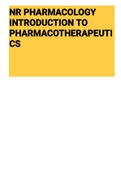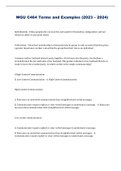NR PHARMACOLOGY
INTRODUCTION TO
PHARMACOTHERAPEUTI
CS
, INTRO TO PHARMACOTHERAPEUTICS
Need at least 2 patient identifiers: Name, DOB, Address, Date of Rx, Prescriber name, address, license number, DEA number if applicable, Info for supervising MD,
Prescription Writing
Drug: name/strength/dose/route/QTY/refills, Signature
• U: write out “unit” • H.S.: write half-strength or at bedtime
• IU: write out “international units” • T.I.W.: write three times weekly or 3 times weekly
• Q.D., Q.O.D.: write out daily or every other day • S.C. or S.Q.: write Sub-Q or subQ or subcutaneously
JC “Do Not Use” List
• Trailing/leading zeros • D/C: write discharge
• MS, MSO4, MgSO4: write morphine sulfate or magnesium sulfate • c.c.: write mL
• µg: write mcg • AS, AD, AU, OS, OD, OU: write out, e.g., both eyes or left ear
ANTIBIOTICS
Class Drug MOA Uses/Coverage ADR/DDI Education/Other
Pen G (IV) Pneumococcal pneumonia
PCN:
Benzathine penicillin (IM) Syphilis, strep throat
1st Gen
Pen VK (PO) Gram + coverage and Treponema pallidum
Nafcillin (IM/IV)
PCN:
Cloxacillin (PO) Antistaphylococcal, MSSA
2nd Gen
Dicloxacillin (PO) Inhibit cell wall
Ampicillin (PO) synthesis, Bactericidal Extended-spectrum: G(+) PLUS some G(-);
PCN: Amoxicillin (PO) OM, URI
3rd Gen Augmentin Diarrhea, Good for beta-lactamase: H.Flu,
(amox + clavulanate) M.Cat
PCN: Zosyn (piperacillin + Broad spectrum, covers Pseudomonas, many
4th Gen tazobactam) (IV) G(-)
Cephalosporin: Cefazolin (IM, IV)
good Gram + coverage, NO MRSA coverage
1st Gen Cephalexin (PO)
Cephalosporins: Cefaclor Not as good G+ but some G(-); OM, Strep
2nd Gen Cefuroxime (IM, IV, PO) pharyngitis
Ceftriaxone good for
Ceftriaxone (IM, IV)
Cephalosporins: Inhibit cell wall better G- but lower G+ coverage, High risk w/ gonorrhea d/t single dose
Cross-sensitivity with PCNs
3rd Gen Cefotaxime (IM, IV) synthesis some for ESBL resistance
Cefixime (PO)
Cephalosporins: Good G+ and G- coverage, Covers
Cefepime (IM/IV)
4th Gen Pseudomonas
Cephalosporins:
Ceftaroline (IV) G- as 3rd-gen plus MRSA coverage
5th Gen
Doripenem
Ertapenem: not good
Ertapenem Inhibit cell wall Broader than other BL-abx May have cross-sensitivity
Carbapenems Pseudomonas coverage
synthesis All IV, IM, saved for very broad coverage to PCNs
Imipenem & cilastatin
Meropenem
Monobactam Aztreonam: IM, IV, inhale Inhibit cell wall G- ONLY, Covers Pseudomonas Never use for empiric tx,
1
, synthesis Good for PCN-allergic
ADR: dose-related
Vancomycin IV Mainly for G+ and MRSA IV Dose for renal fxn, monitor
Inhibit cell wall ototoxicity &
serum levels
synthesis nephrotoxicity; Red man
Vancomycin PO For C. diff. colitis
(infusion NOT allergy)
Inhibit cell wall Alternative to vancomycin ADR: Teratogenic and QT
Telavancin No drug monitoring
synthesis Covers G+ and MRSA prolongation
Erythromycin G+, G-, and atypicals, Often used to treat G+ Allergic reactions are rare!
Inhibit protein
Clarithromycin in pen-allergic patients; ADR: n/v, metallic taste Improved H.Flu vs. E-mycin
Macrolides synthesis, bind to 50s
Enzyme inhibitor: E > C >> A Long 1/2 life, good for
Azithromycin ribosomal subunit
Must watch with: CBZ, warfarin, statins, etc. Chlamydia, other atypicals
High levels of resistance
Coverage very broad: G+, G-,aerobic and
Doxycycline Inhibit protein CI: Avoid with chelating agents (MVI, antacid, milk, iron),
anaerobic, spirochetes, mycoplasmas,
Tetracyclines synthesis, bind to 30s Avoid in pregnancy and small children (<8) – Binds Ca and
rickettsiae, chlamydiae, some protozoa, MRSA
ribosomal subunit will stain teeth
Minocycline PO
ADR: n/v, liver disease, phototoxicity
MRSA, MDRSp, VRE, ESBL-producing G-,
Derivative of
Tigecycline IV many anaerobes, NOT for Pseudomonas; for
minocycline
Complicated SSTIs, intraabdominal ifxn, CAP
Amikacin Inhibit protein
Monitor renal function and serum drug levels!
Aminoglycoside Gentamicin synthesis, bind to 30s G- including Pseudomonas
ADR: ototoxicity, nephrotoxicity
Tobramycin ribosomal subunit
Inhibit protein
Mainly for anaerobic coverage
Clindamycin synthesis, bind to 50s ADR: rashes and high rate of C.diff.
PO or IV and in some topicals, MRSA PO
ribosomal subunit
Inhibit protein PO & IV Caution for Serotonin
Might offer benefit when
Linezolid (Zyvox) synthesis, bind to 50s Use for resistant organisms: MRSA, VRSA, Syndrome
transitioning to outpatient
ribosomal subunit VRE, penicillin-resistant Strep. pneumo
Ciprofloxacin UTI, GI, Pseudomonas
broad G-, ADR: C.diff colitis!! CNS: seizure, dizziness; Cardiac: QT
Levofloxacin Inhibit nucleic acid UTI, GI, LRI, URI, skin
respiratory FQs prolong; MS: tendon, cartilage; Endo: glycemic control;
Fluoroquinolones synthesis – inhibit LRI, URI, GI, skin (no
Moxifloxacin with improved G+ Skin: photosensitivity, rash
topoisomerase UTI!!)
coverage DDI: antacids, Fe, Ca, Zn
Others PO, otic, ophthalmic
Broad with G+ and G-, NO Pseudomonas ADRs: rash (simple to SJS),
TMP-SMX Dose based on TMP (more
Folate Antagonist Common for UTI, MRSA PO photosensitivity, crystalluria
(Bactrim, Septra) important in PO liquid)
(need to counsel)
Miscellaneous Covers protozoa, anaerobes
**DOC: C.diff. colitis
Metronidazole ADR: Avoid with EtOH. Metallic taste
Trichomoniasis; Various infections of: skin,
bone, CNS, GYN, GI, LRI, endocarditis
Nitrofurantoin unclear, thought to Use in simple UTI treatment and prophylaxis CI: ClCr <60 mL/min; Do not use in renal impairment
inhibit several enzyme NOT pyelonephritis or complicated cystitis Warnings/Caution: Hepatic disease, Elderly
pathways and possibly
2
, cell wall synthesis
3





